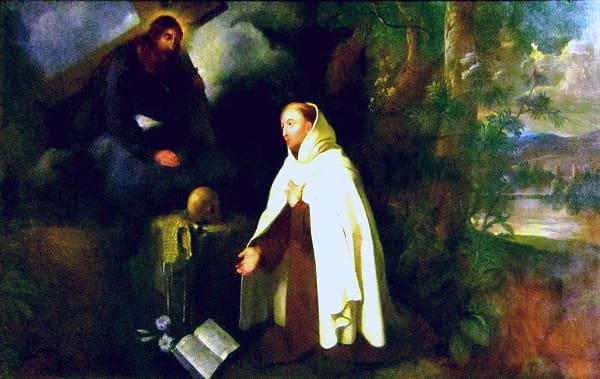A Kneeling Theology
In order to be a compelling force in social renewal, theological wisdom needs the animating power of mystical wisdom. The study of theology needs to be imbued with a deeper contemplation of the Word made flesh. Some presume that recourse to prayer in the context of theological study is anti-intellectual, a flight into fantasy, or even an escape into the merely affective. Such prejudice indicates a disconcerting shift in the nature of theological study.
Theologians of every age have striven to bring theological questions to light in a scientific and disciplined way. A scientific understanding of these questions brings them to light in the highest level of rational consciousness. Yet, for the most part, only in the modern and postmodern eras has such theological wisdom been pursued without regard for mystical wisdom.
It is time to return to a theology studied on one’s knees.
Our greater awareness of method and recourse to technology in theology today seems to be at the expense of prayer. Very few scholars teach or write as if they believe that contemplation is of any objective value to the theological enterprise or that mystical wisdom has any real importance for the life of the Church. At least this is the impression one gets from what is published in many academic periodicals. Can theology without prayer build up the holiness of the Church?
Saint John of the Cross’s Theological Vision
A similar problem began to raise its head in sixteenth-century Spain. Members of the Inquisition and some bishops had come to the opinion that mental prayer was dangerous. This meant that for many people throughout Spanish society, the spiritual life was limited to basic catechesis, restricted liturgical practice, recitation of vocal prayers, and the practice of moral virtue. In the meantime, many were deprived of the deeper devotion to Christ that contemplative prayer makes possible. The Carmelite Reform would be the main cultural force renewing both the Church and the broader society.
Saint John of the Cross lost his father at an early age and grew up in poverty. Through divine providence he received good schooling and had an aptitude for the liberal and fine arts, especially poetry and theology. His education grounded him in a sound humanism and understanding of the Sacred Scriptures. He loved to sing, go on hikes, camp in the wilderness, minister to the sick, and spend time in prayerful solitude.
He became a priest of considerable administrative ability. He not only helped lead the Carmelite Reform during a dangerous period, even enduring imprisonment, but he also established priories and a university. No stranger to politics, his insistence on fairness and kindness caused him to be misunderstood, rejected, and persecuted. This did not discourage the rigorous schedule of spiritual direction he maintained for priests, nuns, and the lay faithful.
To help those entrusted to his spiritual guidance, he composed beautiful poetry by which he would teach important doctrines regarding the life of prayer. In his writings there are references and explanations of what we deem to be theological contemplation, a kind of prayer that takes place deep in the heart. One of his most thought-provoking descriptions of this kind of prayer is linked to the beginning of mystical contemplation:
O Spring like crystal!
If only, on your silvered-over faces,
You would suddenly form
the eyes I have desired,
which I bear sketched deep within my heart.
This ardent prayer, this deep desire emerges in the midst of theological reflection. It represents for Saint John of the Cross a milestone in the ascent of the hidden mountain and entrance into the secret garden of contemplation. We have already seen how he begins the Spiritual Canticle by describing a spiritual awakening in terms of an ardent lover pleading with her beloved to show himself. From this John of the Cross goes on to describe the journey of a soul searching for Christ in terms of the messengers He sends and the enemies that must be faced. Here, he takes us to the threshold of a deeper encounter, a tender face-to-face, a reflection on sacred doctrine that leads to a more mature union with God.
Sacred Doctrine as a Living Fount for Prayer
The soul who withdraws to seek God dwelling in its depths contains a fountain of living water according to Saint John of the Cross. This image speaks to the beauty of the truths of the faith received into the heart. They have the quality of water, which in stillness becomes smooth. The more fully sacred doctrine is received into one’s life, the smoother or more peaceful theology becomes to reflect on.
Beyond a simple mental assent to theological facts, receiving these teachings means to allow them to pierce our dull indifference so that we might treasure them as a gift from a friend. How we treat the gift reveals our attitude toward the giver. Applying oneself to the study of sacred doctrine with grateful devotion purifies and strengthens our faith. Saint John of the Cross is describing this inner purity when he speaks about the surface of these waters being smooth like crystal and as reflective as silver.
What is sought in this reflection and how it is sought constitutes the essential character of theological contemplation. One who is deeply in love thinks about her beloved all the time and, when he cannot be found, yearns to glimpse his eyes in every reflection. Those who ponder the truths of our faith filled with longing for Christ yearn for them to yield a sign of His presence.
The Reflective Quality of Sacred Doctrine
The reflective quality of the water describes an essential characteristic of the sacred doctrine that waters the heart. Saint Thomas Aquinas says that the articles of faith are truth bearing: they bear relation to the First Truth, who is God. Saint John of the Cross brings this insight to bear on Saint Paul’s description that we “see” by faith “dimly” as in “a mirror” (see 1 Cor. 3:12). In the Carmelite’s description of the role of sacred doctrine in prayer, faith finds the revelation of Truth Himself reflected in the articles of the faith as in a mirror.
Saint John of the Cross’s teaching helps explain the enthusiasm we witnessed in Denver during the liturgies of World Youth Day, ’93. There is a relation that the sacred doctrine of our faith bears to the presence of the Lord. The Lord’s presence is accessible to us in propositions of our faith, not with the clarity provided by our natural power of understanding, but obscurely, dimly as if in a reflection.
Sacred doctrine is essential for the spiritual life because it makes it possible to gaze on Christ Himself. The more we study the faith with devotion of heart, the more we expose ourselves to wonder and awe before the Lord. Over and above what we understand theologically, prayerful reflection on what we believe gives a loving general knowledge of Him in a personal and intimate manner.
The “eyes” of the Lord formed in this reflection stir intense desires in the heart, according to the Carmelite Master. In other words, it is possible to be deeply moved, profoundly shaken when in our efforts to ponder our faith we catch the Lord’s piercing love reflected in them. Saint John describes this presence of Christ as no less than “remarkable.” Sacred doctrine, far from remaining on the level of abstract speculation, reflects the gaze of Someone who looks on us with love. When “sketched deep within” the heart, this kind of knowledge occasions spiritual maturity.
+
This article is from a chapter in Fire from Above by Anthony Lilles which is available through Sophia Institute Press. 
Art for this post on kneeling theology: Cover of Fire from Above, used with permission. La Vision de saint Jean de la Croix (The Vision of Saint John of the Cross), Jacques van Oost, 1675-1700, PD-US author’s life plus 100 years or less, Wikimedia Commons.






